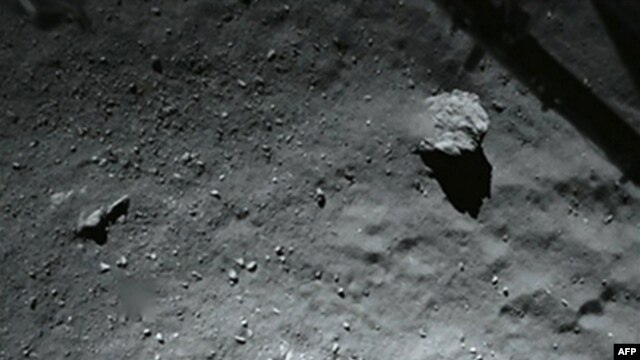European Scientists Face Decisions as Comet Probe Batteries Run Down
A handout photo released on November 13, 2014 by the European Space Agency, and taken by the Rosetta Lander Imaging System instrument, shows the surface of comet 67P/Churyumov-Gerasimenko during Philae's descent.
November 14, 2014 6:50 AM
BERLIN—
European Space Agency scientists will on Friday decide whether to try a risky drilling procedure to anchor an exploration probe to the surface of a comet before its batteries run out.
The lander, released by the Rosetta spacecraft on Wednesday after a 10-year odyssey 500 million km (300 million miles) from Earth, floated away from its planned landing site after harpoons designed to hold it down failed to deploy. The probe is now resting precariously on two out of three legs in the shadow of a cliff on the comet.
The lack of light means the probe, dubbed Philae, would not draw sufficient energy to operate on its solar panels as hoped once its batteries run out later on Friday. The ESA team are also uncertain of its exact position, making it difficult to “hop” the probe into a better position using its landing gear.
The probe - virtually weightless on the comet's surface - was supposed to drill into the surface of the celestial body after landing, but its unstable position means there is a risk it could bounce off if the drill is deployed.
But with the batteries about to run out, the scientists - based at the ESA's operations center in Darmstadt, Germany - told the BBC on Friday that it was time to take more risks with the probe.
Despite the landing setbacks, the 10-year Rosetta mission has achieved many breakthroughs, including the first time a spacecraft has followed a comet rather than just whizzing past and the first time a probe has landed on a comet.
Comets are of interest to scientists because they are remnants from the formation of our solar system, over 4.6 billion years ago. These masses of ice and rock have preserved ancient organic molecules like a time capsule and may provide insight into how planets and life evolved.
Even if Philae is unable to drill into the surface to analyze samples, the Rosetta spacecraft will continue to follow the comet until at least the end of 2015, even as it passes closest to the sun on its orbit.
Philae is also taking pictures and gathering data on how the comet changes during the day.
The ESA will give an update on the mission at 1300 GMT. voa


No comments:
Post a Comment